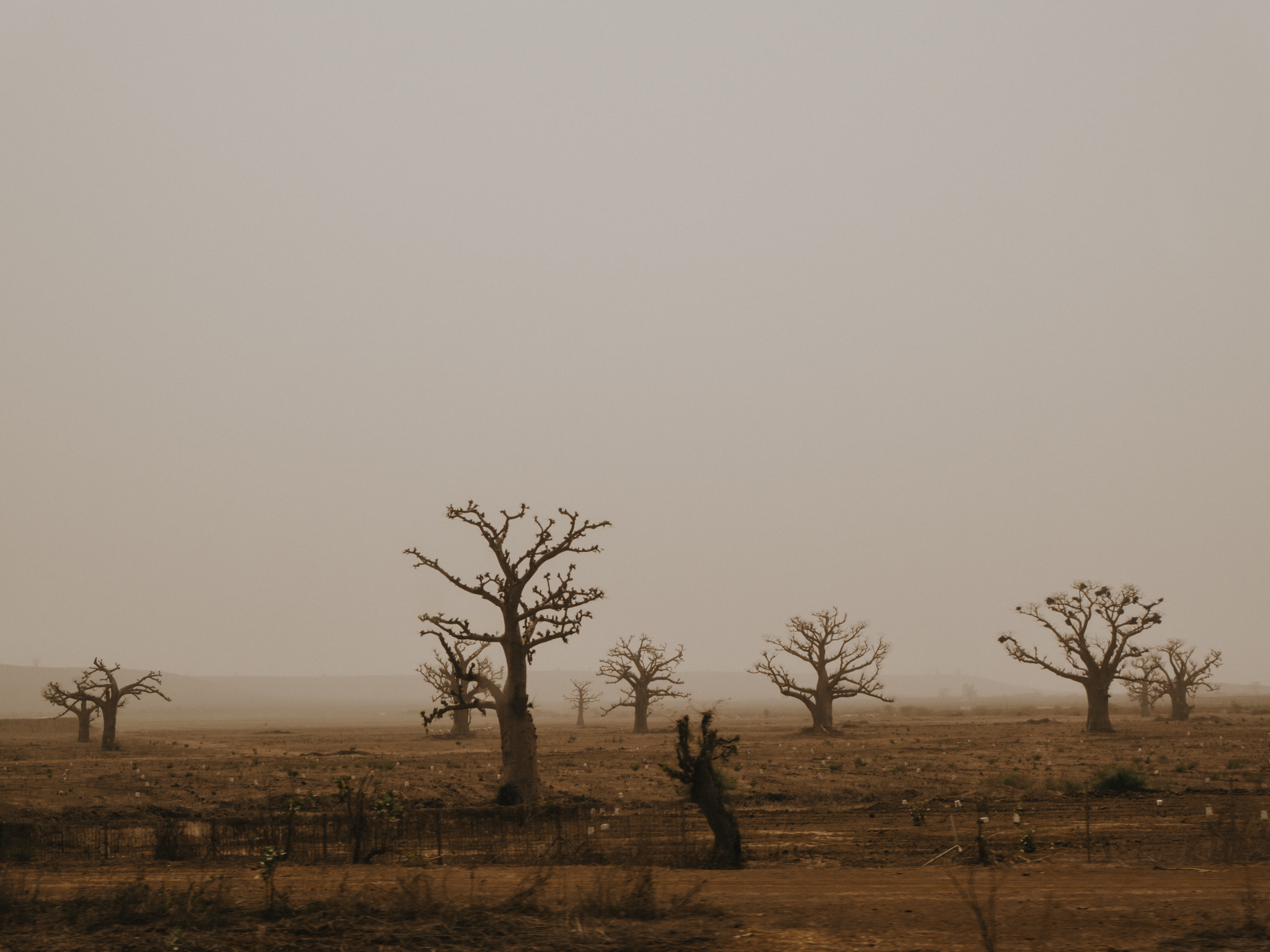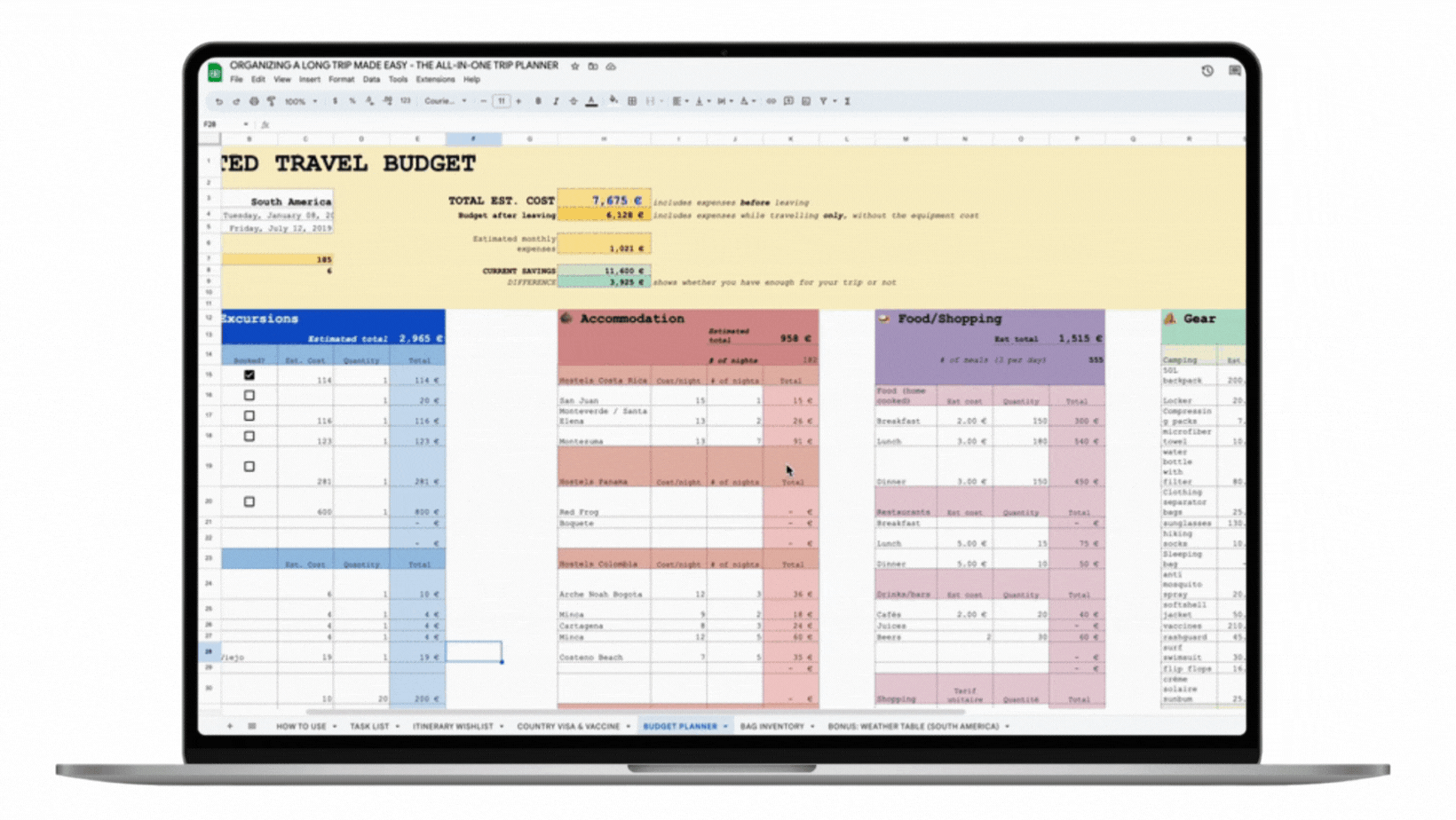HOW TO TRAVEL LONG-TERM ON A BUDGET (+ FREE TRIP BUDGET CALCULATOR)
When planning a long-term solo backpacking trip, your budget will shape where you go, how long you travel for, and the general comfort level of your journey. So if you're broke, have little money, or lack a stable income while travelling, the idea of backpacking long-term can be scary. But prep smart, and you'll be able to travel better, longer, and even save money while on the road. So here's how to travel solo on a budget, with the help of a handy backpacking budget calculator.
09/05/23
![how to make a long-term travel budget for a backpacking trip]()

Step 1: Set your long-term travel budget and financial goals before leaving
Before you embark on your long-term backpacking adventure, it's crucial to establish a realistic budget. It’ll help you know if you have enough money to travel, and how much to save before travelling long-term around the world.
To budget for a backpacking trip, start by determining:
1. The duration of your trip: This can be an estimation. The longer you plan of being away, the earlier you need to start budgeting for your trip.
2. Your desired destinations and activities: Do you want to travel near your home country? Or do you want to cross the globe and explore hard-to-reach islands? Are you planning on hopping from one city to another, or do you prefer slow-travelling? The countries you choose to visit, and your lifestyle and activity choices while travelling, will impact your budget the most.
Some countries and activities (like skiing) are notoriously more expensive, so make sure to take this into account when estimating your long-term travel budget.
Consider the cost of accommodation, transportation, meals, activities, and incidentals for each country. Look for online resources and travel forums, or meet with experienced backpackers to gather information on average daily expenses for each location. This will give you a ballpark figure to work with.
You'll find real-life costs in my travel budget worksheet - money I actually spent during my South America 6-month backpacking trip.
3. Your monthly income: I didn't have a job when I was backpacking through South America. So I had no money coming in. I had to rely entirely on my savings, and that required careful planning before leaving. I had to figure out how much money I needed to save to enjoy my backpacking trip. Not having a monthly income also impacted my way of life while travelling as I had to be careful with my expenses - even though I still had the time of my life and didn't need much money in the end. If you know you'll have a monthly income, factor this into your budget to know how much you can spend each month.
4. Your monthly fixed expenses: Maybe you have a mortgage, a lease, travel insurance, or a phone bill to pay. List all your fixed monthly fees to avoid spending more than you can afford while backpacking solo.
5. The gear you need to buy: Don't overlook pre-departure expenses when budgeting for your trip. From tents to backpacks and hiking gear, these items can add up to hundreds of dollars. Be mindful of these costs to plan your budget effectively.

So that your wallet doesn’t end up as dry as this Baboab field in Senegal ︎
Step 2: Estimate your long-term travel budget with a backpacking budget calculator
A travel budget worksheet is your best friend when it comes to budgeting for your long-term backpacking trip.
Break down your expenses into categories such as accommodation, transportation, food, activities, and miscellaneous costs. Then, assign a daily or weekly budget for each category based on your research and financial goals. Keep track of your expenses during your trip to ensure you're staying within your budget.
On my travel budget worksheet, you'll find:
✔️Transportation costs
✔️Accommodation Costs
✔️Food, Drinks, Shopping
✔️Experiences
✔️Fixed expenses
✔️Administrative costs
✔️Pre-departure costs
The long-term travel budget worksheet will automatically calculate:
- how much money you need to save before taking off
- how much money you can spend each month while travelling
- how much money you can put aside each month while travelling
- total estimated cost of your backpacking trip
It will automatically update the amount depending on the length of your trip. All of the coloured cells below will also update instantly depending on what you input in the travel budget worksheet:

You could do all the work yourself, but if you want to save weeks of planning, why not use a pre-made budget worksheet template?

Step 3: Determine if you actually have money to travel long-term ︎
Once you’re done with estimating your long-term travel budget, take a moment to evaluate your costs, assess your financial situation and determine if you have the necessary funds to go on a long-term solo backpacking trip. If you find that your budget spreadsheet is more red than green, it might be worth considering postponing or reassessing your priorities. Maybe you could do more volunteering, or cut a few activities.
Remember, it's important to make a financially responsible decision that aligns with your current circumstances. By being mindful of your finances, you can better navigate potential obstacles and enjoy a safe and fulfilling journey.
💡 In some cases, living out of a van for a few month can help save a lot of money, especially when backpacking in Australia or Europe.
How to plan a budget-friendly backpacking trip: Tips for estimating long-term travel costs
Now that you know how to create a travel budget, here’s a few tips on how to estimate travel costs for long-term backpacking trips.
1. Estimating accommodation costs
Accommodation is often one of the biggest expenses during a backpacking trip. Consider a mix of accommodation options to suit your budget. Hostels, guesthouses, and budget hotels offer affordable choices. If you're open to unique experiences, consider volunteering. I volunteered 3 months in surf houses in South America and had accommodation and meals covered, which saved me hundreds of dollars.
To find approximate accomodation costs, research accommodation options in your desired destinations and allocate a realistic budget for each - a quick search on bookings.com will give you an idea. Keep in mind that if you book directly with hostels, it'll be cheaper than booking via a platform.
2. Planning transportation expenses
Transportation costs can vary significantly depending on your destination and mode of travel. Look for budget-friendly options such as buses, trains, or shared rides. Consider purchasing transportation passes or cards that offer discounts for multiple trips. Research local transportation systems, schedules, and fares in advance to estimate costs accurately. I travelled from Colombia to Brazil exclusively by bus.
3. Budgeting for meals
Sampling local cuisine is an essential part of any travel experience, but dining out for every meal can quickly add up. To save money on food, consider cooking your meals in hostel kitchens or opting for street food and local markets. Embrace the cultural experience of grocery shopping and preparing your meals. Allow yourself occasional splurges on local delicacies, but balance it with cost-effective dining options.
4. Adding in pre-departure expenses
When preparing for a solo backpacking trip and assessing your long-term travel budget, it's crucial not to overlook the expenses you'll incur before even embarking on your journey. Often, solo travellers make the rookie mistake of disregarding pre-departure costs such as travel visas, vaccinations and essential gear. These expenses can accumulate quickly, easily reaching hundreds of dollars. To ensure accurate budgeting, it's essential to factor in these pre-departure travel expenses along with your other anticipated costs.
5. Factoring in activities and excursions
While it's tempting to try every activity and excursion, be mindful of their impact on your budget. Research and prioritise the experiences that align with your interests and budget. Look for free or low-cost activities such as hiking, surfing, exploring local markets, or visiting public parks and museums. Engage with the local community to discover hidden gems and insider tips for budget-friendly adventures.
Oh, and don’t plan everything ahead! Always leave space for unexpected adventures. Before going to South America, I had never heard of the Huayhuash trek in Peru and certainly didn’t budget for it. But after meeting with locals, it was clear I had to go. And good thing I did - it was the best trek of my life.
6. Accounting for incidentals and unexpected expenses
Unexpected expenses can arise no matter how meticulously you plan your solo backpacking trip. I got my valuables stolen in Ecuador - someone broke the lock and took everything: my cash, laptop, camera, credit cards. So set aside a buffer in your budget for emergencies, unexpected transportation delays, medical expenses, or lost/stolen belongings. A contingency fund will give peace of mind and help you navigate unforeseen circumstances without derailing your trip.
And, of course, get travel insurance. That's non-negotiable.
7. Tracking and adjusting your budget
Keep track of your expenses during your backpacking trip. Use mobile apps, spreadsheets or a travel journal to record your spending. Regularly review your budget and make adjustments as necessary. If you overspend in one category, find ways to compensate by reducing expenses in another. Stay disciplined but also stay flexible to adapt to changing circumstances.
While it’s good to spend money mindfully, don’t stop yourself from enjoying the moment for the sake of a few pennies. If you think something’s worth it,
go for it.


How to plan a budget-friendly backpacking trip: Tips to save money while long-term travelling
Bring quality gear with you: Buying gear while travelling will likely be more expensive. But this depends on where you go, of course. Europe has plenty of options to buy quality gear, but you won't find the same in South America. Invest in backpacking essentials before you leave to avoid spending more bucks than you need while roaming the world.
Get a card that offers free international cash withdrawals in multiple currencies: I chose Revolut and never had any issues with it.
Cook your food and buy local: Avoid buying imported products. Adapt to local cuisine and buy seasonal fruits and veggies to prep your meals.
Dig a little to buy the best souvenirs: For unique and authentic souvenirs, venture beyond the bustling tourist hubs. You’ll often find the best souvenirs in secret shops, tucked away from the crowded markets. Try to avoid spending money on low-quality, mass-produced souvenirs that likely won’t last more than a year. Seek out authentic, locally crafted goods that carry the country’s story and a sense of craftsmanship.
In Cusco, I spent hours exploring the town to find hidden gems. I discovered a local craftsman who was making exquisite handcrafted hippie leather bags and alpaca sweaters. They were so much better than the souvenirs at the central market.
Sometimes, you have to wander a little to find the best deals.
Book excursions with local companies: Similarly, favour local businesses when doing tours instead of choosing international tour companies who often inflate their prices. Check online to read reviews, then walk around in a town to speak directly with local tour operators and book your next adventure.
Volunteer to save money on accomodation and food: As mentioned above, volunteering is one of the best ways to save money while backpacking solo. You can find volunteering opportunities on sites like Workaway and Worldpackers. You can also message hostels directly on IG to ask if they're looking for volunteers.
Whatever your skills and expertise, you surely have something to offer that can help them - from marketing to cleaning and bartending, there’s an opportunity for everyone.
Take the bus: If you're travelling in South America, take the bus to visit the continent. It'll be much cheaper than going by plane. In Europe, many cities are also well connected by buses and trains.
While the idea of spending over 24 hours in a bus to cross a country might seem horrifying, don’t worry. I’ve got you covered with 7 curated playlists for solo backpackers stuck on long bus rides.
Take the plane as your last resort, both to save money and to travel more sustainably.
Book your flight tickets in advance: If you need to take the plane, use sites like Skyscanner to find the cheapest dates. Try to book your flight on a Tuesday, and always search for flights in incognito mode to access the best deals.

FAQ: How to plan a budget-friendly backpacking trip
How can I plan a budget-friendly backpacking trip?
Start by setting a realistic budget, prioritise destinations with lower costs, consider traveling during off-peak seasons, opt for budget accommodations like hostels or camping, cook your own meals, and use a travel budget worksheet to stay in budget.
How can I save money on accommodation during a backpacking trip?
Look for budget accommodations like hostels, guesthouses or camping sites. Consider staying in dormitory-style rooms or shared accommodations to reduce costs. Use online platforms to compare prices and find the best deals. You could also consider house-sitting, couchsurfing or volunteering for free accommodation options.
How can I save money on transportation while backpacking?
Use public transportation whenever possible, such as buses, trains, or shared rides. Walk or cycle for shorter distances. Also, be flexible with your travel dates to take advantage of cheaper flights or train tickets.
What are some ways to cut down on food expenses during a backpacking trip?
Cook your own meals using local ingredients from markets or supermarkets. Look for accommodations with kitchen facilities. Opt for street food or local eateries, which often offer affordable and authentic dining experiences. Avoid eating in touristy areas where prices tend to be higher.
How can I stay within my travel budget while engaging in activities and attractions?
Research and prioritise free or low-cost activities and attractions at your destination. Take advantage of natural sights, hiking trails, or city parks. Visit museums or attractions during their free or discounted hours.
How can I handle money and avoid unnecessary fees while backpacking?
Carry a mix of cash and cards for flexibility. Inform your bank about your travel plans to avoid card blocks. Use local ATMs for cash withdrawals, but be mindful of any associated fees. Consider using banks like Revolut to avoid currency conversion fees.
Is it possible to backpack long-term on a tight budget?
Yes, backpacking on a tight budget is possible with careful planning and smart choices. By volunteering, prioritising budget-friendly options and being mindful of expenses, you can have a fulfilling backpacking experience without breaking the bank.
How much money do you need for a 6-month backpacking trip in South America?
It cost me 6300€, including flights from Europe, to give you a ballpark figure. I didn't stay in the cheapest hostels (always choosing the mid-range ones, from 5 to 12€ per night. I did stay in some expensive hostels (20€ per night), but that was usually because it was my only option). I mostly cooked, rented or bought used surfboards, and volunteered for 3 months. I was travelling slowly, allowing me to enjoy my trip fully and do most of the activities on my wish list.
Your budget will depend on where and when you go, how you travel, and how long you're travelling for. Always budget for unexpected events and expenses. You can't plan everything, but this travel budget template will help you get an idea :)
︎If you need more travel budgeting tips, hit me up. I’d be happy to help.
